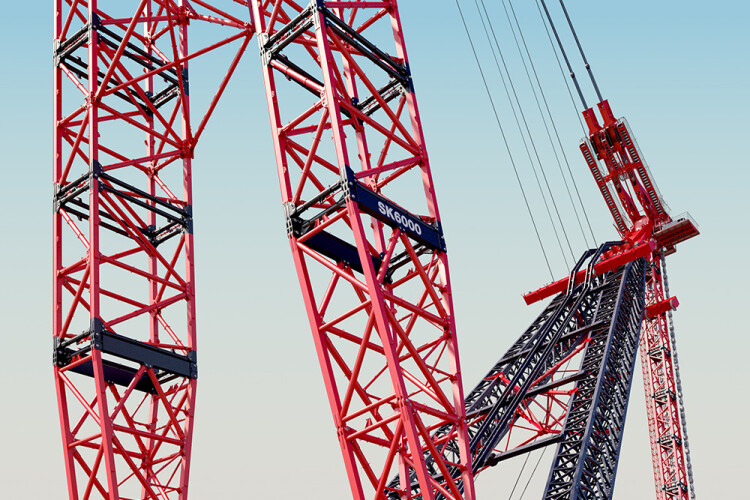There’s a natural human tendency to pursue growth and improvement, which is why our endeavours often focus on bigger, stronger, faster, better. And that’s nowhere more obvious than in the world of cranes.
In fact, there is a well-documented competition to see who can design and build the “world’s strongest crane”. Depending on your chosen criteria, the title-holder can vary: does it mean the theoretical heaviest load (seldom a practical reality) or is it the maximum load at the given outreach? However you want to define it, the contenders are usually a select few – and these days either Belgian or Dutch.
Even this is dwarfed by ocean-going cranes operated by another Dutch company, Heerema, whose SSCV Sleipnir is a semi-submersible vessel fitted with a pair of 10,000-tonne capacity cranes. When it comes to land-based cranes, however, it is Mammoet and its Belgian rival Sarens that compete over who has the biggest tool.
The latest machine to stake its claim is the SK6000 ring crane from Dutch heavy-lift specialist Mammoet.
The new SK6000 has a maximum capacity of 6,000 tonnes and is capable of lifting components weighing up to 3,000 tonnes to a height of 220m.

For the past few years, Sarens has laid claim to the ‘biggest-crane’ title with its SGC 250 – nicknamed Big Carl – which has a maximum lifting capacity of 3,000 tonnes and a maximum load moment of 250,000 tonne-metres.
Big Carl was developed specially for the Hinkley Point C nuclear power station project in Somerset where it has been working since late 2019.
Before that, another giant ring-crane, Abnormal Load Engineering’s AL.SK190 claimed to be the world’s largest. This machine was used by Keltbray on the Earl’s Court demolition project in London in 2017. ALE, a British company, is now part of Mammoet.
“Mammoet acquired ALE in 2020, and along with it the intellectual property of the SK series and other heavy lifting technologies,” says Mammoet. “Since then, the engineering expertise present in the business – the world’s largest heavy lifting and transport engineering hub separate to day-to-day operations – has made the production of this record-breaking machine possible.”
The SK6000 was designed entirely in-house by Mammoet itself, which claims to have “the world’s largest concentration of heavy lift engineering expertise”. This team spent several years working on the crane from engineering concepts to final detailed designs, after which production of the components was contracted to a small handful of trusted fabrication specialists.
In June this year, all the components for Mammoet’s new SK6000 ring crane were delivered to Mammoet’s Westdorpe yard in Zeeland where a team of 20 workers is now busy putting it all together ready for load-testing – a process expected to last at least six months.
Initial works include assembly of the crane’s base frame, power packs and control room. Some of the components are huge (the main boom sections measure 4m x 8m in cross-section) and Mammoet is using several of its ‘smaller’ cranes, including two 250-tonne capacity crawler cranes and a 140-tonne Gottwald harbour crane, to lift and position them.

Ring cranes in this class are intended for transport by sea to job sites anywhere in the world. For this reason, they are invariably designed to be broken down into components small enough to fit into standard steel shipping containers. In the case of Mammoet’s SK6000 the counterweight itself comprises a stack of more than 40 containers which, when filled with sand and gravel, provide approximately 4,200 tonnes of ballast.

With assembly of the crane completed at Westdorpe, Lloyd’s Register will carry out independent certification of the SK6000, including a design appraisal, fabrication survey and a test survey.
“Third-party surveying is not mandatory, but it ensures the SK6000 is built to the highest standards for our customers,” says Mammoet.
The crane will be tested in line with European crane standards and additional side load tests will be performed for compliance with US crane standards. The tests will comprise static and dynamic load test and stability tests. “This ensures the highest safety levels and compliance globally for Mammoet and our customers,” the company says.
The SK6000 has been developed in response to the promise of projects in the emerging energy sectors, such as ‘next-generation’ wind turbines and the foundation components needed for offshore wind farms.
Bottom fixed jackets and monopiles weighing between 2,000 tonnes and 3,000 tonnes are now common, says Mammoet, while next-generation turbine towers between 15MW and 20MW will rise beyond 150m in height. “If global installed capacity targets are to be realised, the supply chain must also grow,” the company says.
The new crane also facilitates new modular construction options for nuclear facilities allowing customers to build more efficiently with larger components, thereby improving the logistics, integration and mobilisation phases of such projects.
You don’t invest the time and money in developing a machine of this size and complexity on a whim, and therefore Mammoet will have prepared a pipeline of work for the SK6000. Nevertheless, it is saying nothing about the SK6000’s first contract, except that it will be somewhere in Asia. “More details to follow…” teased Mammoet’s publicity team.
Mammoet’s project manager for the SK6000, Koen Brouwers, said that delivery of the crane components to Westdorpe was “a thrilling new chapter for Mammoet and modular construction in heavy industry.
“[The crane] will offer a hook height, outreach and lifting capacity far in excess of any crane on the market. We are excited to bring this groundbreaking technology to our customers, helping them achieve their project goals with greater efficiency and more sustainability.”
Assembly and testing of the SK6000 is expected to be complete before the end of
this year.
Got a story? Email news@theconstructionindex.co.uk



